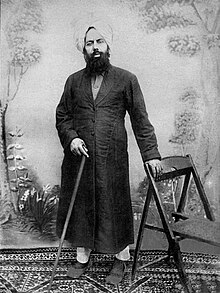Mirza Ghulam Ahmad
| Mirza Ghulam Ahmad | |
|---|---|

| |
| Personlig information | |
| Født | 13. februar 1835 Qadian, Punjab, Indien |
| Død | 26. maj 1908 (73 år) Lahore, Punjab, Pakistan |
| Gravsted | Bahishti Maqbara |
| Far | Mirza Ghulam Murtaza |
| Søskende | Mirza Ghulam Qadir |
| Barn | Mirza Basheer-ud-Din Mahmood Ahmad |
| Uddannelse og virke | |
| Beskæftigelse | Teolog, forfatter |
| Bevægelse | Ahmadiyya |
| Signatur | |
 | |
| Information med symbolet | |

Mirza Ghulam Ahmad (født 13 februar 1835 i Qadian, Sikhimperiet (i dag i Punjab i Indien), død 26. maj 1908 i Lahore, Britisk Indien (i dag Pakistan)) var en religiøs leder og grundlægger af den islamiske bevægelse Ahmadiyya. Han hævdede at være guddommeligt udpeget til at være Messias og Mahdi[1][2] til opfyldelse af Islams dommedagsprofetier.[3][4][5]
Ghulam Ahmad havde et omfattende forfatterskab og skrev mere end 90 bøger om diverse religiøse, teologiske og moralske emner. Han første værk var Barahin-e-Ahmadiyya ('Beviset for Islam') i 1880.[6][7] Mange af værkerne har en polemisk tone og udgør et forsvar for Islam, og søger at dokumentere Islams overlegenhed gennem rationelle argumenter, ofte med Ahmads egen fortolkning af Islam.[8][9] Han var fortaler for en fredelig udbredelse af Islam og argumenterede indgående imod lovligheden af voldelig jihad.[10] Da han døde, havde han et følge på omkring 400.000 personer, særlig i Punjab og Sindh.[11][12]
Referencer
[redigér | rediger kildetekst]- ^ Yohanan Friedmann. Prophecy Continuous: Aspects of Ahmadi Religious Thought and its Medieval Background Oxford University Press, 2003 p 121 "The affinity between the two can also be shown in the framework of Ghulām Aḥmad's prophetology. Muḥammad and Moses were similar to each other because they initiated the two prophetic chains; Jesus and Ghulām Aḥmad complete the divine scheme of things by terminating them. They must therefore also be similar. They resemble each other both in the circumstances of their appearance and in the nature of their prophetic mission. Both appeared when their respective communities were subject to foreign rule: the Jews under the Romans, and the Indian Muslims under the British. The religious conditions prevailing in their communities were also similar. The Jews were described in the Qur'ān (1:7) as "those who earned [divine] wrath" (al-maghḍūb 'alayhim) by their lack of religiosity and by rejecting the message of Jesus. Most Muslims of Ghulām Aḥmad's time can be described in similar terms: their spirituality is lost, and only rituals remain of their religion. Furthermore, they rejected Ghulām Aḥmad in the same way that the Jews had rejected Jesus. In addition to these similar circumstances, Ghulām Aḥmad's message resembles that of Jesus in two important characteristics: he does not advocate jihād, and does not bring a new law, but strives rather to implement the sharī'a promulgated by his predecessor in the prophetic office. And to make the affinity between the two chains total, Ghulām Aḥmad is spiritually greater than Jesus in the same way that Muḥammad was greater than Moses"
- ^ The Essence of Islam, Vol. IV, p. 33
- ^ Adil Hussain Khan. From Sufism to Ahmadiyya: A Muslim Minority Movement in South Asia Indiana University Press, 6 apr. 2015 p 42
- ^ "Chapter Two – Claims of Hadhrat Ahmad". Alislam.org. 1904-06-24. Hentet 2013-05-20.
- ^ "The Fourteenth-Century's Reformer / Mujaddid", from the "Call of Islam", by Maulana Muhammad Ali
- ^ "Introducing the Books of the Promised Messiah (as)".
- ^ An Introduction to the Hidden Treasures of Islam
- ^ Adil Hussain Khan. From Sufism to Ahmadiyya: A Muslim Minority Movement in South Asia Indiana University Press, 6 apr. 2015 p 6
- ^ Brannon Ingram, 'Ahmadi Muslim Americans' in E. E Curtis. Encyclopedia of Muslim-American History Infobase Publishing, 2010 p 32
- ^ Yohanan Friedmann. Prophecy Continuous: Aspects of Ahmadi Religious Thought and its Medieval Background Oxford University Press, 2003 p 174-5
- ^ Valentine, Simon (2008). Islam and the Ahmadiyya jamaʻat: history, belief, practice. Columbia University Press. s. 53. ISBN 978-0-231-70094-8.
- ^ "H.H. Risley and E.A. Gait, (1903), Report of the Census of India, 1901, Calcutta, Superintendent of Government Printing, p. 373". Chinese Heritage of the Australian Federation Project. Arkiveret fra originalen 5. februar 2012.
| Spire Denne biografi er en spire som bør udbygges. Du er velkommen til at hjælpe Wikipedia ved at udvide den. |